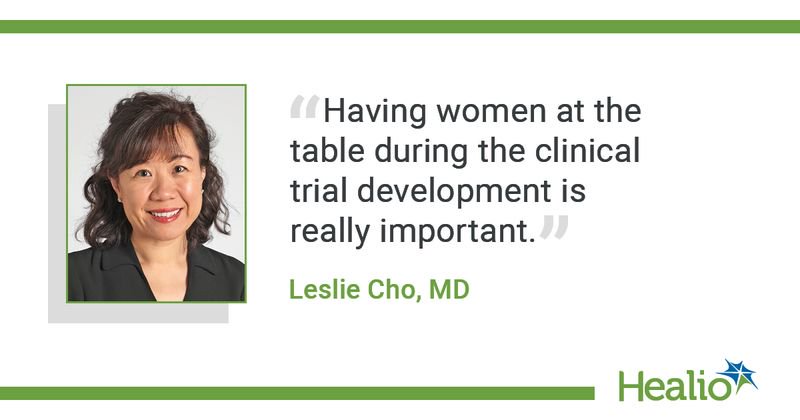Women comprise 10.1% of CV clinical trial leadership
Sex disparities continue in CV scientific leadership, as women are not often present in leadership roles of CV clinical trials published in major journals, researchers found.
“We’ve always known it, but [now we] have a format in which people can all see [these numbers],” Leslie Cho, MD, director of the Women’s Cardiovascular Center and section head of preventive cardiology and rehabilitation in the Robert and Suzanne Tomsich Department of Cardiovascular Medicine at Cleveland Clinic, told Healio. “The time for that movement is really important and really critical. Some physicians will say, ‘Well, there’s not enough talent pool in women,’ That’s not true anymore. To continue this cycle of using the same people over and over again when there are women who are longing for an opportunity is my No. 1 goal in putting out this research.”

Clinical trials in major journals
Kara J. Denby, MD, clinical fellow in the department of cardiovascular medicine at Cleveland Clinic, and colleagues assessed 200 clinical trials related to CV medicine from 2014 to 2018.
“The reason why we picked cardiology is because cardiology trials are big and they’re usually sponsored by companies,” Cho said in an interview. “We thought that cardiology trials may have better representation.”
Journals included in this study were JAMA (n = 41), The New England Journal of Medicine (n = 89) and The Lancet (n = 70). Leadership committees in this study referred to steering committees and executive committees, in addition to primary contributors and study oversight for trials where committee information was not available.
The clinical trials included in this study included 2,433 leadership committee members, of whom 11.1% were women. Women represented a median of 10.1% of committees overall. When assessed by journal, women accounted for 9.4% of trial leadership in The New England Journal of Medicine, 13.9% for JAMA and 8.9% for The Lancet.
Cho told Healio that these results may be due to the same researchers who author several trials within the same specialty.
“People who continue to be in the group happen to be men because they were established earlier,” Cho said. “There are a lot of data out there about women in academic medicine having a more difficult time getting grants and getting professorships. This perpetuates that cycle. It’s the same people on the same type of trials over and over again, and if you never get into the group, you never are then part of the process. It’s really discouraging.”
The mean percentage of women physicians in leadership committees ranged from 5.4% to 6.3%. In addition, 41.5% of trials had no women investigators and 55.5% did not have women physicians on their leadership committees. Of the trials in this study, 9.5% had greater than 25% women on their committees.
Women were first authors for 9.3% of trials and last authors in 10% of trials. Women first authors ranged from 7.1% in The Lancet to 12.2% in JAMA, with women last authors ranging from 8.6% in The Lancet to 17.1% in JAMA.
These percentages were lower in large trials focused on CV procedures, in which women first authors ranged from 6.7% in JAMA to 8.9% in The New England Journal of Medicine and women last authors ranged from 4.3% in The New England Journal of Medicine to 13.3% in JAMA.
In an interview, Cho said that not only do these low percentages of women authors affect leadership roles, but also the recruitment of women in clinical trials.
“If you have this enormous gender disparity in scientific leadership, no wonder we haven’t been able to recruit female patients and having been stuck with the same low enrollment because it’s the same people thinking the same thoughts,” Cho told Healio.
Advice for future clinical trials
Cho said recognition of a lack of women in leadership roles is important, as the situation may be due to implicit bias.
“I don’t think it’s malicious, but I think it is an unconscious bias that we now have to become aware of,” Cho told Healio. “We’re all susceptible to that, myself included. It’s really important to make a conscious effort to include more females in these trials. These are trials recommending therapy for men and women alike, and yet we continue to have this enormous gender disparity in clinical trial recruitment and in clinical leadership. It says something. The first important step towards making this better is awareness.”
In 2019, The Lancet announced it will no longer sponsor all-male panels and its journals will take steps to improve the inclusion of all genders, ethnicities, regions and other social categories in research in publishing. Cho told Healio it may take years to see that impact in clinical trials.
“Clinical trials take years to enroll,” she said in an interview. “Clinical trials ... get started 5 years ago. I bet if we were to look at clinical trial steering groups even today, [the proportion of women] would be incredibly low. Having first authors and all those things are important, but having women at the table during the clinical trial development is really important. These are international companies where most of them have types of gender and race equity policies in place, and yet in the clinical trial, they don’t have that same criteria.”
In a related editor’s note, Tracy Y. Wang, MD, MHS, MSc, professor of medicine, member in the Duke Clinical Research Institute and director of health services and outcomes research at Duke University School of Medicine and associate editor of JAMA Internal Medicine, and Jacqueline Talea DesJardin, MD, clinical fellow at University of California, San Francisco School of Medicine, wrote, “If we are to capitalize on the benefits of a diverse workforce, it must start at the top. The design, conduct and interpretation of clinical trials research can and should maximally benefit from the experience and expertise of both male and female investigators.”
References:
For more information:
Leslie Cho, MD, can be reached at chol@ccf.org.

